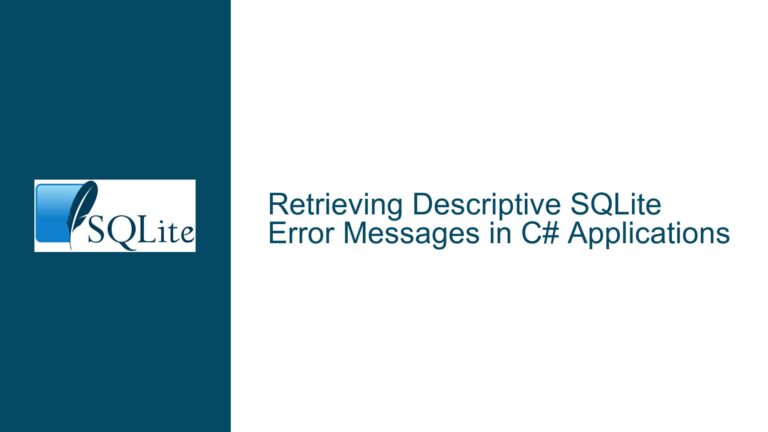Implementing Early Termination in SQLite Virtual Tables via Hidden Pointer Signaling
Understanding the Challenge of Early Termination in Nested Virtual Table Queries
The core challenge addressed here revolves around modifying the behavior of SQLite virtual tables to implement early termination of row generation once a specific condition is met. Traditional SQL queries process all potential rows before applying filters, but in scenarios involving nested virtual tables (e.g., querying hierarchical data structures like JSON), this can lead to unnecessary computation. The goal is to halt row production in a parent virtual table as soon as a child virtual table generates a valid result row, thereby optimizing performance.
This problem is particularly acute when querying tree-like structures where deeper levels of nesting may contain redundant or irrelevant data. For example, a query might need to stop exploring a subtree once a matching node is found. Standard SQL constructs like LIMIT or WHERE clauses are insufficient because they operate on the final result set, not on intermediate stages of row generation within nested loops. A custom mechanism is required to propagate termination signals across virtual table boundaries during query execution.
Key Obstacles in SQLite’s Execution Model and Virtual Table Semantics
Row-Based Processing in Nested Loops:
SQLite executes joins as nested loops, where the outer loop iterates over rows from the first table, and the inner loop iterates over rows from the second table. Each iteration is independent, making it difficult to propagate state (e.g., "stop generating rows") between loops. For example, in a query likeSELECT * FROM a, b, the virtual tableahas no inherent way to signalbto terminate early based on conditions evaluated inb.Lack of State Sharing Between Virtual Tables:
Virtual tables in SQLite are designed to be stateless across method calls. ThexNextmethod of a virtual table cursor advances to the next row, but there is no built-in mechanism for one virtual table to influence the iteration state of another. This makes it impossible for a child virtual table (e.g.,bin the nested loop) to notify its parent (e.g.,a) to stop producing rows once a result is found.Query Optimizer Interference:
SQLite’s query planner may reorder operations or apply optimizations that invalidate assumptions about evaluation order. For instance, predicates in aWHEREclause might be evaluated in an unexpected sequence, causing termination signals to be triggered too early or too late.Hidden Parameter Semantics and Pointer Passing:
While SQLite allows hidden parameters to be passed to virtual tables, using them to share state (e.g., a "done" flag) requires careful handling. Thesqlite3_result_pointerfunction can expose pointer values to SQL, but managing memory lifetimes and ensuring thread safety adds complexity.
Step-by-Step Implementation of Early Termination via Hidden Flags and Pointer Propagation
1. Designing the Custom Virtual Table with Hidden Parameters
Create a virtual table named json_first that includes hidden columns for managing termination flags. The table definition should include:
- Standard columns for JSON elements (e.g.,
key,value,path). - Hidden columns for the JSON input, root path, and termination flags.
Example schema:
CREATE VIRTUAL TABLE json_first(
key ANY,
value ANY,
path TEXT,
json JSON HIDDEN,
root TEXT HIDDEN,
flag_ptr POINTER HIDDEN -- Shared state for termination signaling
);
The flag_ptr hidden parameter will store a pointer to an integer flag variable. When this flag is set (e.g., to 1), the virtual table stops generating rows.
2. Propagating Termination Flags Across Nested Loops
Use SQLite’s pointer-passing mechanism to share the flag between virtual table instances:
- In the outer query, initialize the flag variable and pass its pointer to the first
json_firstinstance. - For nested loops, pass the pointer from the parent virtual table to the child via hidden parameters.
Example query:
SELECT a.key, b.key
FROM json_first(:json, '$.root', :flag_ptr) AS a
CROSS JOIN json_first(:json, a.path, a.flag_ptr) AS b
WHERE b.value = :target_value;
Here, a.flag_ptr is passed to b, allowing b to modify the shared flag. When b finds a matching row, it sets *flag_ptr = 1, causing both a and b to terminate.
3. Modifying Virtual Table Methods to Honor Termination Flags
Implement the following methods in the virtual table’s C implementation:
xBestIndex:
Declare the hiddenflag_ptrparameter as a required input constraint. This ensures the query planner includes the flag in the query execution plan.xFilter:
Initialize the cursor’s iteration state and check the termination flag. If the flag is already set, returnSQLITE_DONEimmediately.xNext:
Before generating the next row, check the flag. If set, returnSQLITE_DONE. Otherwise, proceed with normal row generation.xColumn:
When a row is emitted (i.e.,xColumnis called for visible columns), set the termination flag if the row meets the termination condition. For example:if (condition_met) { *cursor->flag_ptr = 1; // Signal termination }
4. Enforcing Evaluation Order with CROSS JOIN
SQLite’s comma-style joins (FROM a, b) allow the optimizer to reorder tables. To ensure the parent virtual table (a) is fully processed before the child (b), use explicit CROSS JOIN syntax:
SELECT ...
FROM json_first(...) AS a
CROSS JOIN json_first(..., a.flag_ptr) AS b
CROSS JOIN enforces left-to-right evaluation, guaranteeing that a’s rows are generated before b’s. This prevents the child from prematurely terminating the parent.
5. Handling Complex Predicates and Partial Results
To avoid missing valid rows due to early termination:
- Deferred Flag Setting: Delay setting the termination flag until all predicates are evaluated. For example, set the flag in an
xColumnmethod for a synthetic column that is always referenced in theWHEREclause. - Conditional Flagging: Use a user-defined function (e.g.,
json_acknowledge()) to conditionally set the flag based on runtime checks.
Example:
SELECT a.key, json_acknowledge(a.flag_ptr) AS acknowledged
FROM json_first(...) AS a
WHERE a.value = :target AND acknowledged = 1;
Here, json_acknowledge() sets the flag only if the WHERE clause is satisfied.
6. Testing and Edge Cases
Validate the implementation with scenarios such as:
- Multiple Termination Conditions: Queries where multiple nested virtual tables must set flags.
- Subquery Isolation: Ensuring termination flags do not leak across unrelated subqueries.
- Concurrency: Verifying thread safety when the same virtual table is used in parallel queries.
Use SQLite’s EXPLAIN and EXPLAIN QUERY PLAN to inspect bytecode and verify that flag checks are inserted correctly.
By combining hidden pointer parameters, virtual table method modifications, and careful query structuring, it is possible to implement early termination in SQLite without invasive changes to the VDBE. This approach balances performance gains with the constraints of SQLite’s execution model, offering a pragmatic solution for hierarchical data traversal.






